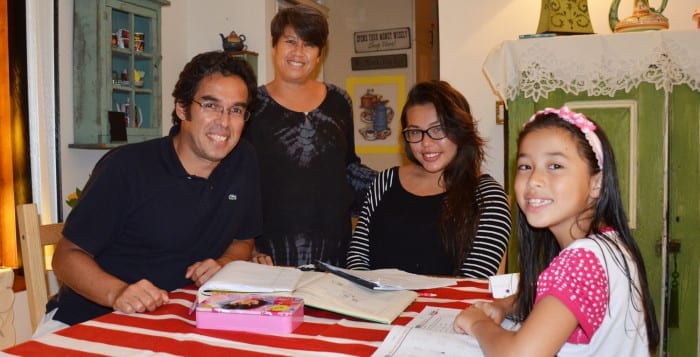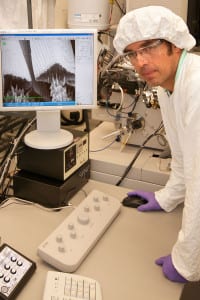BNL’s Camino teams up to reveal fine structures

An ant’s hair might one day cool you off. The Saharan silver ant, which searches for food in such extreme heat that a predator, the desert lizard, often can’t pursue it, may hold the key for builders, designers and manufacturers looking to make the summer heat more bearable.
An international team led by Columbia University’s Nanfang Yu and Norman Nan Shi discovered how these ants, which are 3/8 of an inch in length, cope in temperatures that reach as high as 158 degrees Fahrenheit. To keep their body temperatures below their critical thermal maximum of 128 degrees, the ants use silver hairs to reflect visible and near-infrared light. In the mid-infrared range, they also help the ant’s body give up heat to the sky.
To help understand how these hairs might help, the Columbia researchers submitted a proposal to the Center for Functional Nanomaterials at Brookhaven National Laboratory. Fernando Camino helped reveal their cross-sectional structure while Matthew Sfeir measured the reflectivity of the hairs.
Camino worked with Nan Shi to get a closer look at hairs that are on the top and sides of the ant’s body. Using ion beam milling, Camino and Nan Shi found that the hair has a triangular cross section that is reflective under visible and near-infrared light, which includes the spectrum that has maximum solar radiation. The hair also serves as an anti-reflection layer in the mid-infrared region.
Without this hair, the ants would be 5 to 10 degrees hotter. The scientists reported their results in Science Express online in June. “The results of this [research] could lead to applications that could benefit society,” said Camino.
Camino said the ion beam is like the equivalent of sun blasting with a hose of water, except on a much finer level. “Once you direct the water on the dirt, it starts making a hole,” he said. “That’s what the [focused ion beam] does on a nanoscale.”

For uses in the field of electronics, the ion beam blasts through dense structures like silicon to see individual layers. With the Saharan silver ant hair, however, the beam required adjustments to avoid melting the hair.
“That was my contribution, to find the best parameters to achieve this purpose of exposing the structure without damaging it,” he said.
Chuck Black, the group leader in Materials Synthesis and Characterization at BNL, said the work Camino and Sfeir contributed underscores the importance of the facility.
“This project is a great example of the value of Department of Energy user facilities such as the Center for Functional Nanomaterials,” said Black, who is Camino’s boss. Black said researchers “appreciate [Camino’s] technical abilities and his interest in tackling difficult measurements.”
Camino mixes his time between helping other scientists achieve their goals and pursuing his own research.
Camino’s own research includes working on how to improve the efficiency of organic solar cells. By putting a thin layer of metal on the surface of a solar cell, researchers can create an intense electric field that has the potential to enhance the collection of solar energy.
The focused ion beam enables Camino and his colleagues to pattern this metal layer, using small holes that can focus the energy. This is an ongoing project with challenges including reducing the reflectivity of the metal.
Camino’s specialty is in plasmonics, where he is trying to find other energy applications.
A resident of Port Jefferson Station, Camino lives with his wife Patricia, their 16-year-old daughter Amelia and their 7-year-old daughter Fernanda. Camino and his wife were born in Peru and came to Long Island, sight unseen, in 1996, when Camino pursued his Ph.D in physics at Stony Brook University.
Camino’s father Josue, who was a doctor, told his son not to pursue a career in medicine because of the long professional journey. Camino started working in electrical engineering, where he developed an interest in the basic principles behind the formulas he memorized.Ironically, his physics path proved longer than it would have been in medicine.
When he told his parents he was pursuing his interest in physics, they asked what he could do when he finished studying. The answer lay in the United States. “I’m very grateful for this country for the path it gave me,” he said. “This is a great opportunity.”
As for Camino’s work, Black offered positive reviews. “[Camino] works extremely hard and tries to give time for everyone.”






